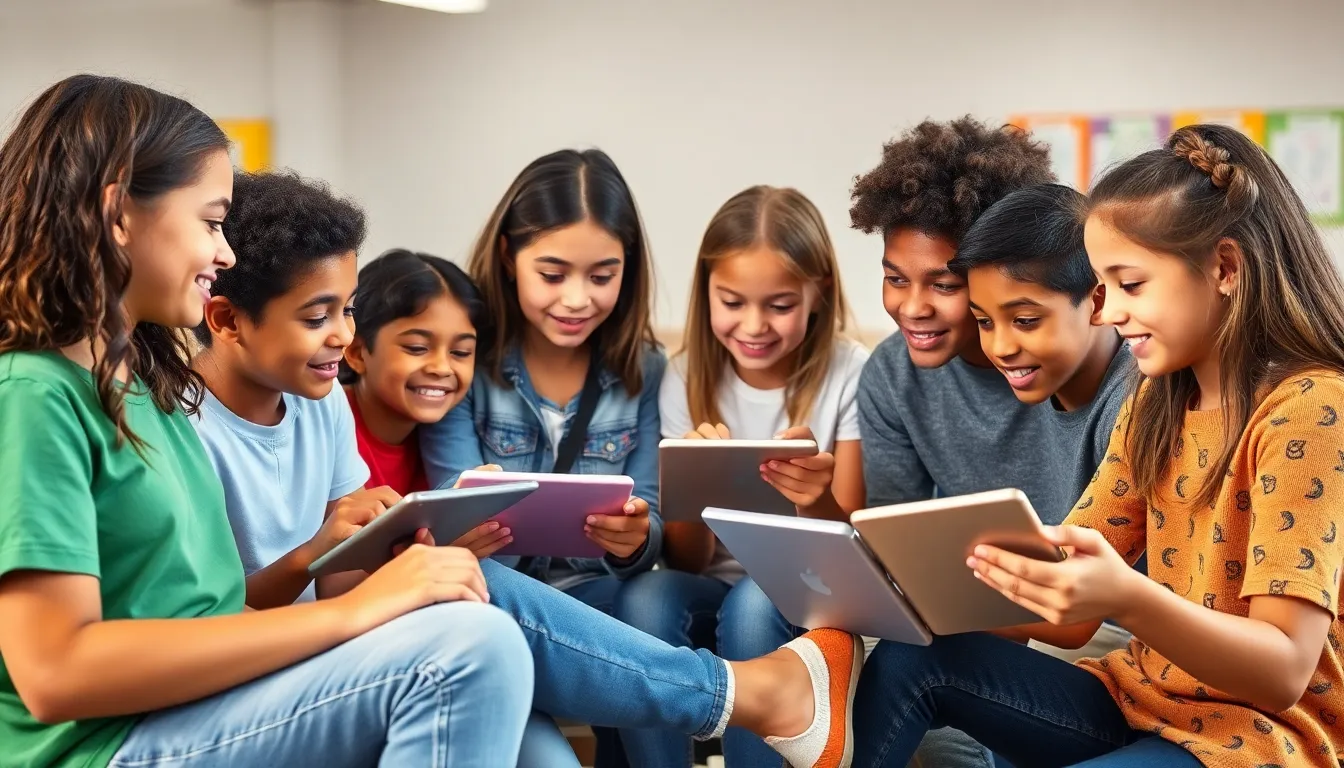In a world where learning knows no borders, multilingual educational apps are like the Swiss Army knives of knowledge—versatile, handy, and ready to tackle any language barrier. Imagine mastering a new language while playing games, solving puzzles, or even chatting with virtual friends. These apps don’t just teach; they make learning feel like a thrilling adventure rather than a chore.
Table of Contents
ToggleOverview of Educational Apps
Educational apps serve as valuable resources, enhancing learning experiences through innovative technology. They cater to diverse learning styles, offering interactive content for users worldwide.
Definition and Purpose
Educational apps represent software designed for facilitating learning through various digital platforms. These applications provide interactive lessons in subjects such as languages, math, and science. Users gain access to resources like quizzes, videos, and exercises. They practice new vocabulary and concepts while engaging with multimedia content. Ultimately, these tools aim to make education more accessible and enjoyable for learners of all ages.
Importance in Modern Education
In modern education, educational apps play a crucial role in personalizing learning experiences. With their ability to adapt to individual needs, they foster engagement and motivation. Students can learn at their own pace, obtaining immediate feedback on their progress. Data suggests that app-based learning can improve retention rates and comprehension. Additionally, they equip learners with skills required in a globalized world, such as multilingual communication and digital literacy. By integrating these apps into traditional education, educators enhance classroom learning and expand resources.
Benefits of Multilingual Educational Apps

Multilingual educational apps offer significant advantages for learners. These tools not only facilitate language acquisition but also promote inclusivity through personalized learning experiences.
Enhancing Language Skills
Multilingual educational apps enhance language skills effectively. Users engage with interactive exercises that involve vocabulary, grammar, and pronunciation. These applications often incorporate games designed to make learning enjoyable. They also adapt to individual learning paces, ensuring that learners grasp concepts thoroughly. Data indicates that users of these apps exhibit improved retention rates, which boosts overall language comprehension. Furthermore, many apps feature speech recognition technology, allowing learners to practice their speaking skills confidently. Exposure to various languages through these platforms fosters an environment conducive to fluency.
Cultural Awareness and Inclusivity
Cultural awareness thrives in multilingual educational apps. These applications introduce various cultural contexts, enabling learners to appreciate diversity. Users encounter real-world scenarios that reflect different traditions and customs, promoting understanding and empathy. Incorporating local expressions and idioms enriches the learning experience while fostering inclusivity. Many apps encourage collaboration among users from different backgrounds, creating a global learning community. They provide resources like videos and articles that explore cultural topics, opening doors to new perspectives. By embracing multiple languages, these apps empower learners to communicate effectively in a globalized society.
Popular Multilingual Educational Apps
Various multilingual educational apps enhance the learning experience by engaging users through dynamic features and content tailored for diverse learners. Below are three popular options that effectively facilitate language acquisition.
App 1: Overview and Features
Duolingo stands out with its gamified approach to language learning. It offers bite-sized lessons that cover vocabulary, grammar, and pronunciation. Users find the app’s interactive exercises enjoyable and effective. Real-time feedback promotes engagement and encourages frequent practice. Duolingo also includes a social component, allowing learners to compete with friends and track progress. The app supports over 30 languages, making it accessible to a wide audience.
App 2: Overview and Features
Babbel provides a structured curriculum for language learners. Lessons focus on practical conversation skills rather than rote memorization. Users appreciate the app’s emphasis on grammar and vocabulary relevant to everyday situations. Speech recognition technology enhances pronunciation skills, fostering confidence in speaking. Babbel offers courses in 14 languages, catering to beginners and advanced learners alike. Its personalized review sessions help users retain what they’ve learned.
App 3: Overview and Features
Rosetta Stone immerses users in language learning through an intuitive methodology. Its speech recognition technology aids learners in developing their speaking skills. The app’s emphasis on cultural context enriches the learning experience, making lessons more engaging. Users appreciate its interactive content, which covers various topics from travel to business communication. Rosetta Stone supports 24 languages, providing a comprehensive learning path for users focused on real-world applications.
Challenges and Considerations
Multilingual educational apps face specific challenges that impact their effectiveness. The accessibility of these apps plays a crucial role in reaching a wider audience.
Accessibility Issues
Accessibility issues can hinder users from fully benefiting from multilingual educational apps. Some users may encounter difficulties due to limited internet connectivity, incompatible devices, or lack of specific language support. Additionally, certain disabilities may complicate navigation through app interfaces. Developers must consider these factors to ensure inclusivity. For instance, incorporating voice commands can assist visually impaired users, while simplified navigation can help those with cognitive challenges. Providing offline functionality further enhances accessibility for users in remote areas.
User Engagement
User engagement is vital for the success of multilingual educational apps. Engaging content retains user attention and motivates learners. Customization features that adapt learning paths to individual needs significantly enhance user experiences. Moreover, interactive elements such as gamification and real-world scenarios increase engagement by making learning enjoyable. Regular updates and new content keep users coming back, ensuring continuous interaction. Feedback mechanisms that allow users to track progress foster a sense of achievement, further promoting active participation.
The Future of Multilingual Educational Apps
Multilingual educational apps continue to evolve, reflecting changes in technology and learner needs. These developments play a crucial role in shaping the future of language learning.
Trends in Development
Artificial intelligence increasingly personalizes language learning experiences in apps. Users benefit from adaptive learning algorithms that adjust to individual progress. Gamification elements engage learners by introducing rewards and challenges. Additionally, integration with social media platforms fosters collaboration among users. Voice recognition capabilities enhance pronunciation practice by providing instant feedback. Focus on inclusive design addresses the needs of diverse learners, making apps more accessible across various backgrounds. Ongoing updates ensure content remains relevant and appealing, catering to user interests.
Predictions for Growth
Projections indicate a surge in the global market for multilingual educational apps. Analysts expect rapid expansion due to the increasing demand for language skills in a globalized world. The rise in remote learning further fuels this growth, as learners seek innovative ways to connect. Increased smartphone penetration in developing regions allows greater access to educational resources. Partnerships between educational institutions and app developers may drive content quality and user engagement. Notably, the focus on cultural awareness and real-world application enhances the overall learning experience, positioning these apps as essential tools for the future of education.
Multilingual educational apps are revolutionizing the way individuals learn languages and engage with diverse cultures. By combining innovative technology with interactive content, these apps create dynamic learning environments that cater to various learning styles and paces. They empower users not only to acquire language skills but also to develop cultural awareness and digital literacy essential for thriving in a globalized society.
As these apps continue to evolve, their potential to enhance education and accessibility remains significant. With advancements in artificial intelligence and user engagement strategies, the future looks promising for multilingual learning. Embracing these tools can lead to enriched educational experiences and better communication across cultures, making them indispensable resources in modern education.








